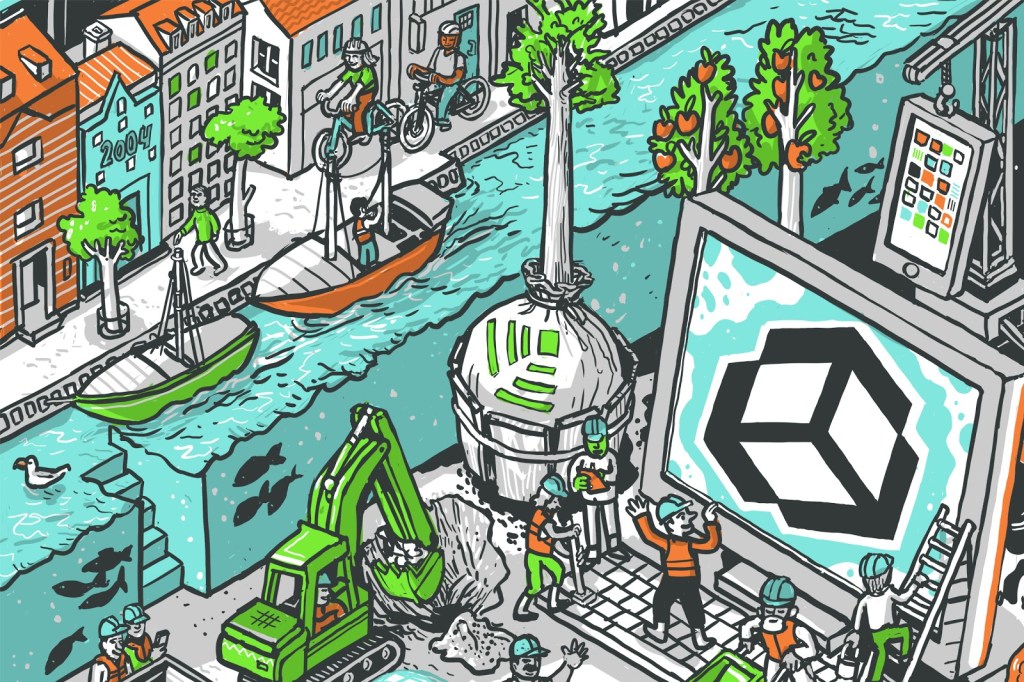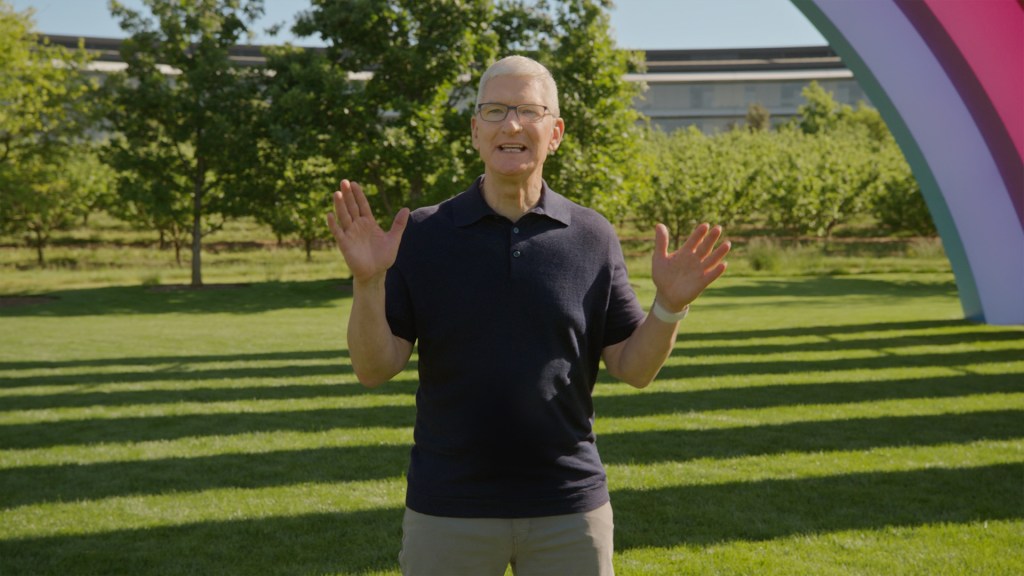What do BMW, Tencent, Pokémon Go creator Niantic, movie director Jon Favreau and construction giant Skanska have in common? They’re all using the same platform to create their products.
Founded in a small Copenhagen apartment in 2004, Unity Technologies’ makes a game engine — a software platform for building video games. But the company, which was recently valued around $6 billion and could be headed toward an IPO, is becoming much more than that.
“Unity wants to be the 3D operating system of the world,” says Sylvio Drouin, VP of the Unity Labs R&D team.
Customers can design, buy, or import digital assets like forests, sound effects, and aliens and create the logic guiding how all these elements interact with players. Nearly half of the world’s games are built with Unity, which is particularly popular among mobile game developers.
And in the fourteen years since Unity’s engine launched, the size of the global gaming market has exploded from $27 billion to $135 billion, driven by the rise of mobile gaming, which now comprises the majority of the market.
Unity is increasingly used for 3D design and simulations across other industries like film, automotive, and architecture and is now used to create 60% of all augmented and virtual reality experiences. That positions Unity — as Facebook CEO Mark Zuckerburg argued in a 2015 memo in favor of acquiring it — as a key platform for the next wave of consumer technology after mobile.
Unity’s growth is a case study of Clayton Christensen’s theory of disruptive innovation. While other game engines targeted the big AAA game makers at the top of the console and PC markets, Unity went after independent developers with a less robust product that was better suited to their needs and budget.
As it gained popularity, the company captured growth in frontier market segments and also expanded upmarket to meet the needs of higher-performance game makers. Today, it’s making a push to become the top engine for building anything in interactive 3D.
This article is part of my ongoing research into the future of interactive media experiences. This research has included interviews with dozens of developers, executives, and investors in gaming and other industries, including interviews with over 20 Unity executives.
Founding
Unity was founded in Copenhagen by Nicholas Francis, Joachim Ante, and David Helgason. Its story began on an OpenGL forum in May 2002, where Francis posted a call for collaborators on an open source shader-compiler (graphics tool) for the niche population of Mac-based game developers like himself. It was Ante, then a high school student in Berlin, who responded.
Ante complemented Francis’ focus on graphics and gameplay with an intuitive sense for back-end architecture. Because the game he was working on with another team wasn’t going anywhere, they collaborated on the shader part-time while each pursued their own game engine projects, but decided to combine forces upon meeting in-person. In a sprint to merge the codebases of their engines, they camped out in Helgason’s apartment for several days while he was out of town. The plan was to start a game studio grounded in robust tech infrastructure that could be licensed as well.
Helgason and Francis had worked together since high school, working on various web development ventures and even short-lived attempts at film production. Helgason dropped in and out of the University of Copenhagen while working as a freelance web developer. He provided help where he could and joined full-time after several months, selling his small stake in a web development firm to his partners.
According to Ante, Helgason was “good with people” and more business-oriented, so he took the CEO title after the trio failed to find a more experienced person for the role. (It would be two years before Ante and Francis extended the co-founder title and a corresponding amount of equity to Helgason.)
They recruited a rotating cast to help them for free while prototyping a wide range of ideas. The diversity of ideas they pursued resulted in an engine that could handle a broad range of use cases. Commercializing the engine became a focus, as was coming up with a hit game that would show the engine off to its best advantage; for indie developers, having to reconstruct an engine with every new game idea was a pain point that, if solved, would enable more creative output.
Supported by their savings, a €25,000 investment from Ante’s father, and Helgason’s part-time job at a café, they pressed on for three years, incorporating in the second year (2004) with the name Over The Edge Entertainment.
The game they ultimately committed to launching in spring 2005, GooBall, was “way too hard to play,” says Ante and didn’t gain much traction. Recognizing that they were better at building development tools and prototypes than commercially-viable games, they bet their company on the goal of releasing a game engine for the small Mac-based developer community. Linking the connotations of collaboration and cross-compatibility, they named the engine Unity.
5 stages of Unity’s rise
Devotees can dive into exhaustive documentation of every update to Unity’s game engine since launch, but for the uninitiated, its journey from new product to the world’s most used game engine was separated into five stages, each triggered by a business decision that expanded its reach to more developers.
Beginning with the founders bootstrapping their company for five years before raising outside capital, what jumps out about this story is their consistent focus on the niche customer segments overlooked by other engines, and their early recognition that enabling export of a game to many different types of devices would become increasingly critical.
As Helgason told me over lunch in the cafeteria of Unity’s Copenhagen office, “It feels like every year we made at least one really good decision, and every year the world did something really nice to us.”
Unity’s release
In June 2005, the Copenhagen-based trio launched their game engine in front of the whole Mac developer community at Apple’s WWDC State of the Union. The demo went well, Ante recalled, “But we had like one customer. That’s $200.” Restricted to Mac-based developers, Unity’s customer base grew slowly and steadily for the first couple years, from a few new customers per week to a few per day and eventually a few per hour.
Unity 1.0 didn’t have many features and could initially only be used to publish games to Mac OS X, although an update released a year later enabled exporting to Windows and web-based play, a well-timed move given surging interest in casual online games. But Mac-based developers had far fewer options to pick from, since most of the game developer market used PCs.
What set Unity apart was its workflows. The team had written it editor-first with the goal of making it easy to use for a range of project types before retrofitting the engine’s underlying code to work with their editor. Nearly every other licensable game engine took the opposite approach; developers would build their own engines from scratch for each game, and some would then license engines to others with a retrofitted editor tacked on as an afterthought.
Inspired by the user interface of Photoshop and Final Cut Pro, Unity was easier to use and less labor intensive for importing assets like artwork and audio.
According to Helgason, the founders decided early on that Unity’s mission was to “democratize game development.” Rather than join other game engine creators in chasing the business of the biggest studios that demand optimal graphical rendering and system performance,
Unity served the needs of indie developers, optimizing for ease of use and cross-platform compatibility.
Prior to Unity, a developer seeking to license an engine had to call the company, pitch their project, and agree to pay a substantial upfront licensing fee. Unity, however, made its license available for self-service on its website and offered free trials. Helgason says they adopted a “cheapium” pricing model: Unity cost $1,500 for the full professional license and just $200 for the basic hobbyist.
According to a talk Helgason gave at London Business School, the licensing model was inspired by Fog Creek Software founder Joel Spolsky, who said there’s no good price point for business software between $1,000 and $75,000, given the cost difference between a self-service model and face-to-face sales team model. (They of course priced Unity slightly above Spolsky’s suggested limit but the point on choosing between self-service vs. enterprise sales held.)
Unity 2.0
The release of Unity 2.0 in October 2007 provided the core features most customers would expect from a good engine like a terrain engine, character rendering, dynamic shadows, directional lights, and more. This “made it a real engine, less beta-ish,” says Helgason. The update enabled Unity to gain more market share among Mac developers, since “we were the only game in town basically,” recalls Ante, who took the CTO title. The team could afford a few employees although they were always just barely paying the bills. It also formally adopted the name of its product as its corporate name.
Given the company’s indie focus, it operated in constrained computing environments where processor speed, RAM, and storage were at a premium. Its founders wanted their customers’ games to be played on small devices like small laptops that were below the standards demanded by professional hardcore gamers.
To ensure cross-compatibility, Unity also built a port for the Nintendo Wii, which was the most open console to date and so small they were restricted to just 88MB RAM. Few developers jumped aboard to create games for Wii despite how many units Nintendo sold, but the experience trained Unity’s team to build for a very small device.
The rise of mobile gaming
When Steve Jobs announced the iPhone in January 2007, the Unity team got excited. They were already Macheads, and the iPhone was going to be fairly open for third-party applications. The first generation iPhone was very small and lacked a marketplace for apps, but the second generation iPhone launched in June 2008 was similar in power to the Wii component-wise and premiered the App Store. Unity introduced the ability to export games to iOS shortly after.
Professional game developers at top studios didn’t take iOS seriously given the weak specs of the device (relative to a console or PC), so neither did other engine makers. Even as the iPhone passed 1 million devices and 10 million devices, popular game engines continued to ignore the mobile market. Indie developers jumped on the new format, however, flooding the App Store with mobile games built in Unity.
Helgason says he didn’t predict the enormous growth of the App Store. In fact, by the time they released Unity’s port for iOS, called Unity iPhone, he felt they missed the initial hype cycle and were possibly too late. But by 2012, mobile games accounted for 18% of the global gaming market, rising to 51% by 2018 through market expansion.
Unity would enable exporting to Android in March 2010 soon after the release of Unity 3.0, expanding its market share in mobile gaming overall.
Windows version
Unity’s next major customer expansion stemmed from the release of its Windows runtime at the annual Game Developers Conference in 2009 that expanded its reach into PC gaming. Given Unity’s dominance in mobile games, many developers were buying Macs just to make use of it. Ante says his team had to rebuild most of the engine’s editor in order to make it platform independent, a major undertaking, but “overnight,” the majority of Unity customers were on Windows due to its massive market share.
It was during this year that Unity — still just a team of 25-30 people — raised its first round of outside investment, a $5.5 million Series A led by Sequoia Capital, and expanded from Copenhagen to add an office in San Francisco (it already had many team members working remotely outside Denmark).
VMWare founder Diane Greene had introduced Helgason to the Sequoia team after looking at Unity as a tool for building an education startup idea. Helgason gave his first pitch on a Friday then came back the following Monday to pitch all the partners. On the Sunday in between, he was discussing the fundraising process with a friend at a café in San Francisco and was interrupted by a man at the table next to him — Natera CEO Matthew Rabinowitz.
Rabinowitz had overheard Helgason and gave a strong endorsement of Sequoia partner Roelof Botha, who was a Natera board member. Helgason and Botha turned out to have natural chemistry the next day as well, leading Botha to take point on the deal and gain a board seat at Unity.
From Cheapium to Freemium
After the ascent of mobile and the addition of the Windows runtime, Unity’s decision in October 2009 to offer a basic tier of its engine completely free to hobbyists was the third massive stimulus to the growth of its user base.
Botha says his firm saw a switch to freemium as a big untapped opportunity when they invested. “If you want to be a developer ecosystem company, you want to have as many developers as possible working on your platform.”
A free version wouldn’t just expand market share, it would expand the overall market of people using game engines. Botha says it took a few months for the Unity executive team to come around to the idea but their decision to adopt it was “a real crucible moment for the company.” Unity’s active user base roughly doubled on the first day of the freemium model, he claims.
As a byproduct of enormous user growth, Unity’s developer community became a differentiator. The internet flooded with how-to videos, blog posts, and discussion forums created by Unity developers for Unity developers, which in turn caused more people to adopt Unity. The engine also swept into universities and other education programs as the go-to tool for learning game development, creating a generation of young professionals who use Unity by default.
In November 2010, Unity introduced the Asset Store, a marketplace where developers can sell digital assets they created or buy such assets from others. Asset Store saves an enormous amount of collective labor hours within the industry: there’s no need to create a forest, sound effects or a visual scripting tool from scratch when plenty of others have done it before.
Initially, the free version of Unity had a restricted feature set compared to the paid version, but with the later release of Unity 5.0 in 2015, Unity updated its free tier to be a Personal Edition with the same functionality as the Professional Edition. The distinction between the tiers was that game developers generating more than $100,000 in revenue had to use the Professional Edition.
In 2016, Unity switched from a freemium licensing model to a freemium subscription model, aligning it with the SaaS model that’s become the norm among B2B software and giving customers automatic access to latest Unity feature set, instead of having to license each new edition.

Expanding Unity’s vision
These moves propelled Unity into the most-used game engine in the world, even though big studios still hadn’t adopted it. The company raised an additional $17 million in 2011, grew its team across offices around the world, and its once-broke founders became millionaires many times over.
However, as headcount grows into hundreds of employees, a company starts having not just two but sometimes three levels of management, explained Helgason, “and the leaders that you need for that era are often quite different from the ones who had before…I don’t think I would have been very great at it.”
Helgason laid the groundwork for a CEO transition in November 2013 when he recruited John Riccitiello to the board and put the idea on the table. Riccitiello had been CEO of Electronic Arts (EA), the publicly-traded game publisher that is the second-largest gaming company in North America & Europe. “He wasn’t just a board member that came around for coffee once a quarter, but was super active,” recalled Helgason, “We traveled together. We were together, like, a day per week at least.”
In October 2014, Riccitiello took over as CEO. Helgason remains a regular visitor and an advisor but no longer has a day-to-day role. Francis, who was Chief Creative Officer, had left the company in 2013 to focus on developing his own games. Ante remains as the only founder on staff, continuing as CTO to this day and acting as Unity’s unofficial spokesperson to the developer community.
Having risen from three young guys in a cheap Copenhagen apartment to the world’s most popular game engine, Unity achieved its original vision. Riccitiello set an ambitious path to upgrade Unity’s technical capabilities, expand product offerings to support game developers with all their needs, and make Unity the engine for building 3D content beyond gaming as well. And he raised a war chest to fund these initiatives, expanding the number of engineers from roughly 100 when he took over to around 1,500 today.
I’ll explore the future of Unity further as part of my analysis of the interactive media landscape more broadly over the next few months. Sign up for the Extra Crunch newsletter to be notified of subsequent posts on game engines’ role in shaping the next era of gaming and shaping the future of digital experiences across industries.































Comment